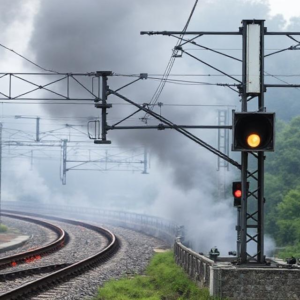Indian Railways plays a very important role during natural disasters such as floods, earthquakes, cyclones, and landslides. When disasters happen, people need quick help, and railways often provide the fastest and safest way to transport both relief materials and people. Let’s explore how Indian Railways helps during natural disasters in simple terms.

1. Providing Emergency Relief
When a natural disaster strikes, one of the first things needed is emergency relief, including food, medicine, and rescue teams. Indian Railways helps by:
a. Transporting Relief Supplies
- Trains are used to transport relief materials like food, water, blankets, and medicines to disaster-hit areas. Railways can carry large amounts of goods over long distances quickly and efficiently. This is especially important when roadways are damaged, and other modes of transportation cannot reach the affected areas.
b. Bringing Rescue Teams and Medical Help
- Trains are also used to bring rescue teams, including doctors, paramedics, and soldiers, to the disaster areas. Special medical teams are sent to help injured people, and first aid kits are delivered by train.
2. Evacuating People
During disasters like floods or cyclones, many people may be trapped or at risk of harm. Indian Railways plays a crucial role in evacuating people from danger zones.
a. Special Trains for Evacuation
- Indian Railways can run special trains to evacuate people from areas where roads are blocked or unsafe. For example, during floods or when cyclones hit coastal areas, trains are sent to pick up people and move them to safer places.
- These special trains can carry thousands of people at a time, and they may even be used to transport people away from flooded regions or areas affected by other disasters.
b. Providing Shelters and Temporary Facilities
- Sometimes, stations are used as temporary shelters for people who have lost their homes in disasters. Indian Railways ensures that these shelters have basic amenities like food, water, and medical care.
3. Restoring Services
After a natural disaster, the railway infrastructure such as tracks, stations, and signaling systems can get damaged. Indian Railways works quickly to restore normal services:
a. Rapid Track Repair and Restoration
- In cases of earthquakes or floods, railway tracks may get damaged. Indian Railways has teams that can quickly repair damaged tracks. These teams are trained to work in emergency situations, ensuring that the trains can start running again as soon as possible.
b. Clearing Blocked Routes
- Sometimes, roads or railways can get blocked due to landslides or floods. Indian Railways has special recovery teams that clear these obstacles. They use heavy machinery like cranes and excavators to remove debris and restore rail services.
c. Temporary Track Diversions
- If a track is badly damaged and can’t be repaired immediately, Indian Railways may create temporary tracks or diversion routes to keep trains running. This helps prevent a complete halt to the transportation of people and goods.
4. Communication and Coordination
During disasters, quick and clear communication is essential. Indian Railways is a key player in coordinating rescue and relief operations.
a. Setting Up Emergency Communication
- Emergency control rooms are set up to coordinate with local authorities, emergency teams, and disaster management organizations. These control rooms help direct resources to where they are most needed and ensure smooth communication between all parties involved.
b. Informing Passengers
- Indian Railways makes sure that people are informed about any train cancellations, delays, or alternative routes during a disaster. This helps travelers stay safe and makes sure they know what to do.
5. Post-Disaster Rehabilitation
After the disaster, Indian Railways also helps in the rehabilitation and rebuilding process.
a. Transporting Construction Materials
- Rebuilding infrastructure and homes after a disaster requires large amounts of construction materials like cement, steel, and wood. Indian Railways transports these materials to the affected areas quickly and efficiently.
b. Supporting Long-Term Relief
- Indian Railways continues to support long-term relief efforts by running regular trains that transport goods and people to areas where recovery efforts are still ongoing.
6. Special Measures During Different Types of Disasters
Indian Railways takes special actions depending on the type of disaster:
a. Floods
- Flooded tracks can be dangerous, so Indian Railways monitors weather forecasts and water levels. Trains are often rerouted or canceled in flood-prone areas to avoid accidents.
- Pontoon bridges or temporary bridges can be used to restore rail links when normal bridges are washed away.
b. Cyclones
- During cyclones, high-speed winds can damage overhead electric lines, and tracks can become covered with debris. Indian Railways takes precautions by suspending trains in the affected areas and then working on restoring services as soon as the cyclone passes.
c. Earthquakes
- In the event of an earthquake, the tracks and stations are inspected for damage. Any safety risks are addressed before trains can resume running.
7. Training and Preparedness
Indian Railways has special teams and plans to deal with disasters:
- Disaster Response Teams: Indian Railways has special rescue and relief teams trained to respond during emergencies. They are prepared for situations like train accidents, floods, or landslides.
- Disaster Management Plans: Indian Railways has its own disaster management plans to quickly assess the situation, deploy resources, and ensure the safety of passengers and staff.
Conclusion
Indian Railways plays a critical role during natural disasters by providing emergency relief, evacuating people, restoring services, and coordinating efforts to help affected communities. Whether it’s delivering relief materials, evacuating thousands of people, or quickly repairing damaged tracks, Indian Railways helps save lives and reduce the impact of disasters. Thanks to its vast network and preparedness, Indian Railways is a lifeline during tough times, helping people rebuild and recover after natural disasters.
Keywords: Indian Railway, Railway











